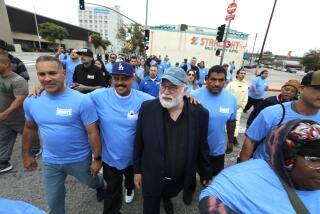Little Church of Immigrants Stands Up to Be Counted
Within the faded stucco walls of a church in Boyle Heights--a church so small that when 300 people show up for Mass it’s “sardine-ville,” its pastor says--is a little parish that picks big fights.
In the space of one year, the faithful of Dolores Mission Catholic Church have voted to defy the federal government and declare their church a sanctuary for anyone uprooted by the new amnesty law. They took on Sears, the nation’s biggest retailer, over aliens’ job rights. They marched through the drug-infested housing projects next door, demanding more police protection. They picketed the Immigration and Naturalization Service at noon every day of Lent, and they sent a scolding letter about human rights abuses to the president of El Salvador, with a copy to Ronald Reagan.
On Saturday--day seven of a two-week hunger strike protest by 10 church members--they took a bus caravan to Orange County, to the home of regional INS Commissioner Harold Ezell.
Among them was a Guatemalan couple; she qualifies for amnesty, her husband does not. They were married at Dolores Mission. Their three children were baptized there. They went to kneel in front of Ezell’s house and “pray,” the husband said, “that it will help him to see.”
Activist Parishioners
This is not some dying church sparsely attended by old ladies in black, in a silence unbroken but for the snick of rosary beads. The viejitas of Dolores Mission are “the first ones there” when anything is afoot, said co-pastor Fernando Arizti; a 71-year-old was arrested on Cinco de Mayo when she chained herself to 12 fellow protesters and an INS gate.
These are bold actions from anyone; from an undistinguished, unrich parish of mostly undocumented Latinos in the most populous archdiocese in America, they are extraordinary.
And they are not what everyone thinks a church ought to be doing.
When Dolores Mission declared itself a sanctuary in December, the telephone jangled with death threats and bomb threats; if no one was there to answer the phone, the callers left their violent messages on the answering machine.
Someone with a black marker scrawled “Wetback Church” on the front steps one night. Pastor Greg Boyle was all for scrubbing it off. Don’t you dare, his parishioners told him; that is a sign that we’re doing something right.
Whatever they are doing, it is galvanizing this neighborhood at the edge of the Los Angeles River.
With just a year or so under the direction of an ardent new pastor and co-pastor--Boyle is 33, a Jesuit in his first parish, and Arizti, 54, is a Mexican-born veteran of 18 years in Chicago’s housing projects--the lights are always on at Dolores Mission; indeed, a church committee, mindful of vandalism, was hard-pressed to dissuade Boyle from keeping its doors unlocked around the clock.
Handout From Food Bank
People go to the door for a handout from the impromptu food bank, where donated supplies vary from white onions to designer yogurt. Lately, some have stopped by to say goodby. Fearing they will not qualify for amnesty, they have been heading back to Mexico--among them the woman who played Mary in the church’s Passion Play. But since spring, 12,000 Latinos--twice the number in the parish--have chosen this place to pre-register for amnesty.
The priests hold regular outdoor liturgies under the clotheslines of the Pico-Aliso housing projects, whose 2,250 residents are mostly their parishioners. Sometimes in the new vestments made from brilliant Mexican serapes, they preside over five Spanish and one English Mass each Sunday, in a church that has become so crowded that they had to open up the choir loft, used for years just to store Christmas decorations.
The Neighborhood Watch program has blossomed in the crime-ridden projects and the streets that skirt them. “The priests support us a lot,” said Lucy Mendoza, Neighborhood Watch senior block captain. There are almost as many of the orange-and-black Neighborhood Watch warning signs visible these days as there are the bumper stickers reading “Yo Dolores Mission.”
A spiritual-political “high” is gripping many here, in the midst of a three-month series of “vigils and fasts and acts of civil disobedience, even,” Boyle said. One parishioner with a 22-year-old son with drug problems said Boyle “tries to help him, sometimes loaned him money, advised him and is looking for a job for him. When I was in Santa Monica, I only went to church, that was all--I never saw the priests communicating with the people like that.” She gladly toted an anti-drug protest sign; “I honor the padres for trying to help my son.”
Boyle’s birth certificate may show that he’s a California-born Irishman, church secretary Romie Armenta said, “but at heart he’s a Mexican.”
Boyish looking and bearded, and looking like a student in his worn brown corduroy pants and a blue Yale sweat shirt, Boyle is uncomfortable with such talk. Neither man, Arizti said, likes “the old Bing Crosby style” of the benign, aloof priest.
“For me it is grace upon grace to be with these people. Boy, have they ever taught me what it means to follow the Lord.”
Compliment Returned
Parishioners return the compliment, like firebrand illegal alien activist Carmen Lima, one of the hunger strikers, who said that since Boyle came here, even early Mass is jammed. “‘I’ve never seen so many people getting up so early.”
Another hunger striker, Jose Gonzalez, qualifies for amnesty but his wife does not. He drives several miles out of his way to attend Dolores Mission because “here, we have a voice; here, they are like us.”
That is the thinking Boyle brings to this, his first parish. After learning Spanish in Bolivia, Boyle can now put into practice the theories he had only philosophized about before at divinity school in Berkeley.
Grounded in the “liberation theology” of Latin America, Boyle urges parishioners to feel their “power to change the situation, to speak out boldly for the gospel and their own key fundamental human rights.”
It was not without tension at first, among a congregation where class tiers were vaguely felt: at the top, legal Latinos, then illegal Mexicans, then illegal Central Americans at the bottom, recalls Boyle, who had to convince them that the issues that affected one group, for good or ill, affected them all.
Down to Basics
“We really rolled up our sleeves and duked it out a little bit” in church. For the unlettered, Arizti drew cartoons: “The Right to a Good Education,” a dreaming youth with visions of college above his head, and “The Right to Work,” a man puzzling over a sign offering jobs at $2 an hour. Decisions like sanctuary are regularly discussed at Mass, then put to a vote.
The keystone to this spiritual activism is a network of 10 comunidades eclesial de base, small weekly discussion groups of 15 or 20, whose members “proclaim the gospel and live it and change situations that are unjust,” Boyle said.
At one recent meeting, conducted in Spanish, feelings ranged from the prayerful to the indignant.
The dozen-plus people had nudged every chair in the small house into the living room for the Bible reading--a verse in Jeremiah in which God tells someone to “go without fear.”
“Does anyone have any comment on this?” Arizti asked.
“That’s very appropriate for what we’re doing, isn’t it?” a gray-haired woman said.
Added a man in aviator glasses, “It applies to all of us who don’t have papers, who are afraid of the migra. “
A Hymn and Hugs
They ended the meeting with a hymn and a round of abrazos --hugs--just as the hunger strikers were beginning their meeting at the church office.
They had had one press conference about their fast, and were contemplating another. If this was to work, it must be seen to work, as well. The office walls are covered with press clippings of the church’s doings; the fast, and this prayer vigil, will bring new ones.
“I think every day we’re in this strike, we’ll get more press,” said one striker, a plump man in a white T-shirt. “It’ll just become more and more and more.”
“We should call UPI (United Press International),” insisted a man in a red shirt.
The others looked at him, perplexed.
“Well,” he said triumphantly, “the new owner is Mexican!”
More to Read
Sign up for Essential California
The most important California stories and recommendations in your inbox every morning.
You may occasionally receive promotional content from the Los Angeles Times.











